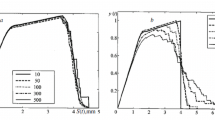Abstract
A new approach, based on Daniels' statistical model for a parallel fibre bundle and the recent results on yarn mechanics by the present author, is introduced to predict the strengths of twisted yarns including the effects of interfibre friction and the fibre fragmentation mechanism during yarn extension. By calculating the lateral pressure in a twisted yarn, the critical fibre length of the fibre fragmentation process has been determined, and was found to decrease together with the increasing yarn strain. This, according to the Weakest link theorem, will lead to a substantial increase of fibre strength. Incorporating this conclusion into Daniels' result yielded a more realistic prediction of the strength and its boundary for a twisted fibre structure. The key differences between a filament yarn and a short-fibre yarn and their effects on strengths are also discussed. The major results from the study are illustrated schematically.
Similar content being viewed by others
References
J. W. S. Hearle, P. Grosberg and S. Backer, in “Structural Mechanics of Yarns and Fabrics”, Vol. 1 (Wiley Interscience, New York, 1969).
A. Kemp and J. D. Owen, J. Textile Inst. 46 (1955) T. 684.
M. M. Platt, Textile. Res. J. 20 (1950) 1.
R. R. Sullivan, J. Appl. Phys. 13 (1942) 157.
F. T. Peirce, J. Textile Inst. 17 (1926) 355.
H. E. Daniels, Proc. R. Soc. A183 (1945) 405.
D. G. Harlow and S. L. Phoenix, J. Compos. Mater. 12 (1978) 314.
S. L. Phoenix, Textile Res. J. 49 (1979) 407.
B. M. Rosen, in “Fiber Composite Materials” (American Society for Metals, Metals Park, Ohio, 1965) p. 37.
C. J. Monego and S. Backer, Textile Res. J. 38 (1968) 762.
N. Pan, M. L. Palmer, M. H. Seo, M. Boyce and S. Backer, in “Proceedings of the International Conference on Fiber and Textile Science”, Edited by M. W. King, April, Ottawa, Canada, 1991, p. 179.
N. Pan, Textile Res. J. 62 (1992) 749.
A. Kelly and N. H. Macmillan, in “Strong Solids”, 3rd Edn (Clarendon Press, Oxford, 1986) p. 252.
I. Dogu, Textile Res. J. 42 (1972) 726.
H. L. Cox, British. J. Appl. Phys. 1 (1952) 72.
N. Pan, Polym. Compos. 14 (1992) 85.
B. D. Colman, J. Mech. Phys. Solids 7 (1958) 60.
W. Weilbull, J. Appl. Mech. 27 (1951) 293.
B. D. Agarwal and L. J. Broutman, in “Analysis and performance of Fiber Composites”, 2nd Edn (Wiley, New York, 1990) p. 124.
Author information
Authors and Affiliations
Rights and permissions
About this article
Cite this article
Pan, N. Prediction of statistical strengths of twisted fibre structures. JOURNAL OF MATERIALS SCIENCE 28, 6107–6114 (1993). https://doi.org/10.1007/BF00365030
Received:
Accepted:
Published:
Issue Date:
DOI: https://doi.org/10.1007/BF00365030



